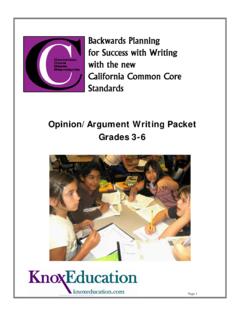Transcription of Guide to Scoring Rubrics
1 Guide to Scoring Rubrics What is a Scoring rubric ? How do you know if your students have learned something you ve taught in the classroom? Evaluating the learning process is no simple task. Since learning is a dynamic and complex process, teachers need a diverse set of tools for measuring the progress of his/her students. One of those tools is the Scoring rubric . A Scoring rubric is a standard of performance for a defined population. It is a pre-determined set of goals and objectives on which to base an evaluation. In the Higher Education Report, Brookhart describes a Scoring rubric as, Descriptive Scoring schemes that are developed by teachers or other evaluators to Guide the analysis of the products or processes of students' efforts.
2 This article will explore in depth the different types of Scoring Rubrics , how to make one yourself, as well as an analysis into how Scoring Rubrics enhance learning. Types of Scoring Rubrics Despite the overwhelming number of Scoring Rubrics you can find on the Internet and in various textbooks and curriculum guides, most Rubrics fall into one of two categories: Analytic or holistic Scoring Rubrics . Analytic Scoring Rubrics Analytic Rubrics attempt to break down the final product or goal into measurable components and parts. In other words, your student has a project or assignment and you use an analytic Scoring rubric to evaluate all the pieces of the project.
3 Analytic Rubrics typically use numbers to measure quality. Let s take the example below. Student Assignment: Write a one-page paper on your summer vacation. The rubric might break down the evaluation process into three parts- content of the paper, grammar and mechanics, and organization of ideas. For each of these components, numbers would be assigned. (1) Needs improvement, (2) Developing, (3) Goal, (4) Above average, (5) Excellent The rubric also explains what exactly each of those numbers mean. So a student might have a score like this: Content (3) Ideas were developed and thought out.
4 Examples were given. Grammar (4) The paper was free of all spelling and grammar errors. There were only a few awkward sentences. Organization (2) Each idea was not separated out into paragraphs. Author jumped around and confused the reader. With an analytic Scoring rubric , the student and teacher can see more clearly what areas need work and what areas are mastered. It is far more descriptive than a simple A, B, or C grade. Holistic Scoring Rubrics Whereas analytic Rubrics break down the assignment into measurable pieces, a holistic Scoring rubric evaluates the work as a whole.
5 In the above example, a holistic rubric would look like this: Student Assignment: Write a one-page paper on your summer vacation. (1) Needs improvement: The story is not clearly organized, grammar errors make it difficult to understand, and content is lacking. (2) Developing: The student has a grasp on the assignment but needs to spend more time organizing thoughts, adding details, and fixing errors. (3) Goal: The student has completely the paper using good content, correct, grammar, and a logical organization of ideas. (4) Above average: The story is full of great content, organized well, and free from spelling and grammar errors.
6 (5) Excellent: The student went above and beyond, adding rich detail to his/her story. The content is interesting and organized well. Thoughts are well described. Grammar and mechanics are flawless. With this rubric , the piece is evaluated as a whole. General or task-specific? Rubrics can be either. General Rubrics are used across multiple assignments. Once you have developed a general rubric , you can use it to measure different subjects and lessons. Task-specific Rubrics are designed to evaluate one specific assignment. Using these guidelines, you can categorize your Rubrics into one of the following categories: General holistic Scoring rubric General analytic Scoring rubric Task-specific analytic Scoring rubric Task-specific holistic Scoring rubric General holistic Rubrics have advantages and disadvantages.
7 If you spend the time to create a solid Scoring rubric , you won t have to do it again. Students will quickly grasp the meaning of each number- therefore understanding what needs improving from assignment to assignment. The value of each number is clear. The disadvantage to this type of rubric is that different subjects may need more specific Scoring instructions. With the same rubric used over and over again, your or your students might get stuck in a rut always using the same score. General analytic Scoring Rubrics are difficult to create.
8 Since an analytic rubric is designed to break an assignment into pieces, the best bet is to create a general analytic rubric for a particular subject (like one for writing, one for math, one for reading, etc.). Each subject has similar measurables something that would be difficult to create across different disciplines. Task-specific analytic Scoring Rubrics are the most comprehensive and detailed. While they provide a great source of feedback to the student and teacher, it does require more work upfront to create. Creating a task-specific analytic rubric for each assignment would be tremendously tedious.
9 Save these types of Rubrics for projects that are large and need to be broken down into parts and pieces for your students to manage and understand. Task-specific holistic Rubrics are like the balanced middle of the road rubric . They are designed for a particular assignment, but evaluate it as a whole rather than in parts. Creating a Scoring rubric Why is it important to create Scoring Rubrics for your students? Well for one, it helps to spell out clearly what you expect from them in terms of quality, content, and effort. It gives you an objective criterion on which to base a grade, eliminating a lot of the It s not fair!
10 Mentality that can creep in when grades seem arbitrary. It allows your students the opportunity to understand more comprehensively your expectations of performance. A Scoring rubric can also be used for peer-to-peer evaluation. This is another way to engage your students in the learning process. 1. Decide what kind of rubric you are going to make- general or task specific, and then analytic or holistic. 2. Use a Word processing software or Excel to make a chart. 3. If you are creating an analytic Scoring rubric , divide the project or assignment up into parts (for example, a math project might have the categories creativity, understanding of mathematical concepts, correct answers, presentation, effort, etc.)







